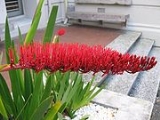
Xeronemataceae
Encyclopedia
Xeronemataceae is the botanical name
of a family
of flowering plants, placed in the order
Asparagales
of the monocots.
The name was published in 2000 and has therefore been recognized only in recent taxonomies. The APG III system
of 2009 (unchanged from the 1998
and 2003
versions) does recognize this family.
The single genus in the family, Xeronema
, with two species, has been variously placed in the family Asphodelaceae
or the family Hemerocallidaceae
in other taxonomic systems
. One species, Xeronema callistemon
, is native to two islands off of the north coast of the North Island
of New Zealand
and the other, Xeronema moorei, is native to New Caledonia
. The plants are herbaceous monocots, spreading by rhizomes, and have large flowers set on terminal spikes, with stamens towering above the flowers.
Botanical name
A botanical name is a formal scientific name conforming to the International Code of Botanical Nomenclature and, if it concerns a plant cultigen, the additional cultivar and/or Group epithets must conform to the International Code of Nomenclature for Cultivated Plants...
of a family
Family (biology)
In biological classification, family is* a taxonomic rank. Other well-known ranks are life, domain, kingdom, phylum, class, order, genus, and species, with family fitting between order and genus. As for the other well-known ranks, there is the option of an immediately lower rank, indicated by the...
of flowering plants, placed in the order
Order (biology)
In scientific classification used in biology, the order is# a taxonomic rank used in the classification of organisms. Other well-known ranks are life, domain, kingdom, phylum, class, family, genus, and species, with order fitting in between class and family...
Asparagales
Asparagales
Asparagales is the name of an order of plants, used in modern classification systems such as the APG III system . The order takes its name from the family Asparagaceae and is placed in the monocots. The order has only recently been recognized in classification systems...
of the monocots.
The name was published in 2000 and has therefore been recognized only in recent taxonomies. The APG III system
APG III system
The APG III system of flowering plant classification is the third version of a modern, mostly molecular-based, system of plant taxonomy...
of 2009 (unchanged from the 1998
APG system
The APG system of plant classification is the first, now obsolete, version of a modern, mostly molecular-based, system of plant taxonomy that was published in 1998 by the Angiosperm Phylogeny Group. It was superseded in 2003 by a revision, the APG II system, and then in 2009 by a further...
and 2003
APG II system
The APG II system of plant classification is the second, now obsolete, version of a modern, mostly molecular-based, system of plant taxonomy that was published in April 2003 by the Angiosperm Phylogeny Group. It was a revision of the first APG system, published in 1998, and was superseded in 2009...
versions) does recognize this family.
The single genus in the family, Xeronema
Xeronema
Xeronema is a genus of flowering plants containing two species:* The Poor Knights lily is endemic to the Poor Knights Islands and Taranga Island in the north of New Zealand. It was discovered in 1924. The Poor Knights lily has large bottlebrush flower clusters that grow horizontally. The clusters...
, with two species, has been variously placed in the family Asphodelaceae
Asphodelaceae
Asphodeloideae is a subfamily of the monocot family Xanthorrhoeaceae in the order Asparagales. It has previously been treated as a separate family, Asphodelaceae. The subfamily name is derived from the generic name of the type genus, Asphodelus...
or the family Hemerocallidaceae
Hemerocallidaceae
Hemerocallidoideae is the botanical name of a subfamily of flowering plants, part of the family Xanthorrhoeaceae sensu lato in the monocot order Asparagales according to the APG system of 2009. Earlier classification systems treated the group as a separate family, the Hemerocallidaceae. The name...
in other taxonomic systems
Plant taxonomy
Plant taxonomy is the science that finds, describes, classifies, identifies, and names plants. It thus is one of the main branches of taxonomy.Plant taxonomy is closely allied to plant systematics, and there is no sharp boundary between the two...
. One species, Xeronema callistemon
Xeronema callistemon
Xeronema callistemon is a species of flowering plant endemic to the Poor Knights Islands and Taranga Island in the north of New Zealand. It was discovered in 1924 and has a common name Poor Knights Lily...
, is native to two islands off of the north coast of the North Island
North Island
The North Island is one of the two main islands of New Zealand, separated from the much less populous South Island by Cook Strait. The island is in area, making it the world's 14th-largest island...
of New Zealand
New Zealand
New Zealand is an island country in the south-western Pacific Ocean comprising two main landmasses and numerous smaller islands. The country is situated some east of Australia across the Tasman Sea, and roughly south of the Pacific island nations of New Caledonia, Fiji, and Tonga...
and the other, Xeronema moorei, is native to New Caledonia
New Caledonia
New Caledonia is a special collectivity of France located in the southwest Pacific Ocean, east of Australia and about from Metropolitan France. The archipelago, part of the Melanesia subregion, includes the main island of Grande Terre, the Loyalty Islands, the Belep archipelago, the Isle of...
. The plants are herbaceous monocots, spreading by rhizomes, and have large flowers set on terminal spikes, with stamens towering above the flowers.

